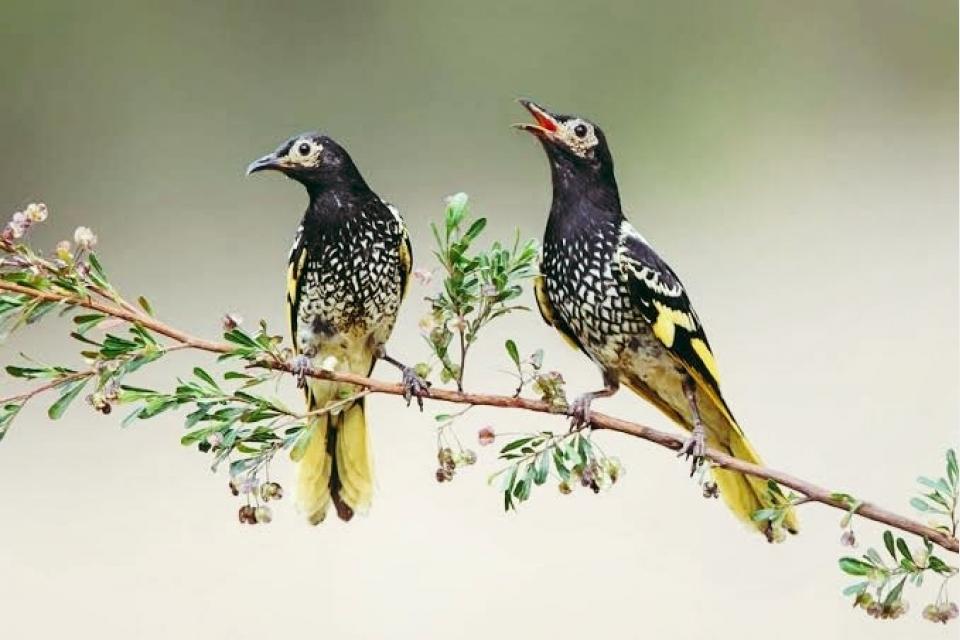A medium sized bird, black with yellow markings, sits on a tree branch.
The birds were released to boost numbers of the critically endangered species.
Regent honeyeaters are a striking bird, but there are only about 300 left in the wild and efforts are continuing to save the species from extinction.
A captive-breeding program is underway with around 60 birds released in the Hunter Valley — the largest ever release in NSW.
"We know from modelling that's been done that to keep this species going, we have to release zoo-bred birds into the wild every few years," Birdlife Australia's NSW woodland bird program manager, Mick Roderick, said.
"We've just released 58 regent honeyeaters into the Lower Hunter region, which is really exciting. That's about 20 per cent of the entire population."
Formerly more widely distributed in south-eastern mainland Australia, the core of the regent honeyeater population is now restricted to NSW.
"This is by far the biggest release we have done in the core of the bird's range," Mr Roderick said.
Birds welcomed to Wonnarua country
An Aboriginal woman, stands talking, in traditional clothing, with indigenous designs.
Tara Dever, CEO of Mindaribba LALC, was present at the regent honeyeater release.(Supplied: Alex Pike and Mindaribba LALC)
The birds were released on Wonnarua country, on land owned by Mindaribba Local Aboriginal Land Council, within the Kurri Kurri and Cessnock Woodlands.
BirdLife Australia has been working with the community for several years implementing actions to help save the regent honeyeater.
Mr Roderick said it gave the release even more meaning.
"It's a very special place. We were welcomed and the birds were welcomed by the Mindaribba Local Aboriginal Land Council," he said.
"There was a smoking ceremony and many impassioned words spoken.
"It's a real journey. The conservation and cultural values of this land are just enormous."
A black and yellow medium sized bird sits on a tree branch.
This wild regent honeyeater was found breeding in the same bushland as the Hunter Valley release site.(Supplied: Mick Roderick and Mindaribba LALC)
Mr Roderick said the release location was carefully chosen and contained key eucalypt species, along with an important mistletoe species, helping to provide a rich habitat.
"In the lead up to the release we've found several pairs of wild birds in the region too, including one that was nesting," he said.
Many groups have been involved in the project including Birdlife Australia, the NSW Department of Planning, Industry and Environment and their Saving Our Species program, Taronga Zoo Conservation Society Australia, and the Mindaribba Local Aboriginal Land Council (LALC).
High hopes of survival
Regent release tracking
Some of the birds have been fitted with tiny radio transmitters to track their movements and survival.(Supplied: Alex Pike and Mindaribba LALC)
All the newly released birds have been fitted with a combination of colour bands, and about half of them have also had tiny radio transmitters attached to track their movements and survival over the coming months.
"We have set our survival benchmark quite high, which is about 70 per cent survival at 10 weeks," Mr Roderick said.
"Just a week after the release of these birds we have seen some birds pair off and behave like they are establishing territories and wanting to construct nests, so it's really exciting."
Regent honeyeater on branch.
Regent honeyeater numbers are low in the wild, largely due to loss of their woodland habitat.(Supplied: Mick Roderick)
The Regent Honeyeater Recovery Team has now released a total of 373 birds into the wild across south-eastern Australia since 2000.
Mr Roderick said there were many occasions where released birds were sighted years later.
"In the past few months we've had a bird that was released in Chiltern in Victoria in 2015, that was seen in Victoria six years later," he said.
A man stands in bushland holding a radio antenna.
The birds are fitted with tiny radio transmitters and monitored after their release. So far all have survived.(Supplied: Alex Pike and Mindaribba LALC)
"And we've had birds that were released in 2017, that have been seen nesting recently.
"One of those birds from the 2017 release actually turned up in Sydney last year … quite close to where it was raised at Taronga.
"It does appear that releasing these birds does work because they survive, and we have evidence of them breeding."
Rediscovering its own song
A black, white and yellow bird sitting on a bare branch, with its beak open.
Low numbers of mature regent honeyeaters makes it hard for juveniles to learn how to sing.(Supplied: Murray Chambers)
There have been concerns that with numbers in the wild so low, some regent honeyeaters are failing to learn their own song.
"Often when we encounter a lone male regent honeyeater, the song it's doing is not that of a regent honeyeater," Mr Roderick said.
"It's actually learning the song of other birds, so it's a little bit sad in that this species is potentially losing its song.
"So we take steps to address that with the captive population by trying to train the birds to sing correctly … otherwise a wild female might not be too impressed."
Mr Roderick said, at the latest regent honeyeater release, parallels were made with the Wonnarua people also reawakening their own language.
"To have these birds, a species where song is being lost, on country where language has largely been lost and is being reawakened, is just incredible really," he said.
Tara Dever, CEO of Mindaribba Local Aboriginal Land Council, said it was a special project.
“What is special about this release site and the partnership with Mindaribba, is the work being done with the honeyeaters and their song culture runs almost parallel to the reawakening of Wonnarua language by respected Wonnarua elder Aunty Sharon Edgar-Jones,” Ms Dever said.
An Aboriginal woman stands in a bush area, in a long robe, smiling.
The birds were released on Wonnarua country, on land owned by Mindaribba Local Aboriginal Land.









